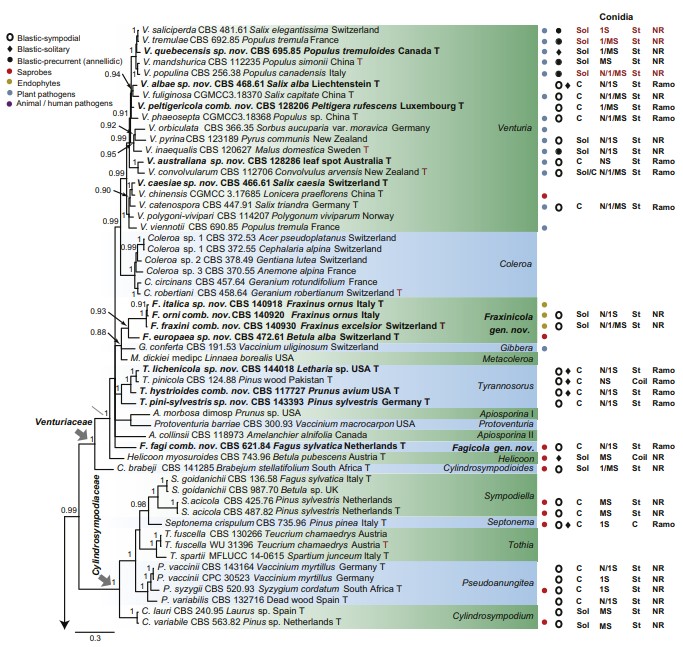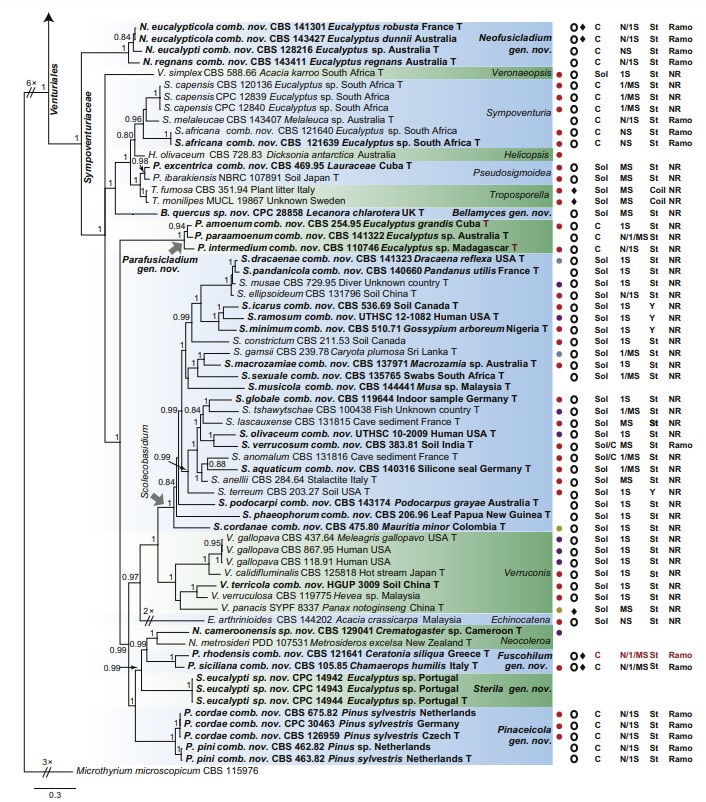Sterila eucalypti Crous, M. Shen & Y. Zhang ter, sp. nov.
MycoBank number: MB 831522; Index Fungorum number: IF 831522; Facesoffungi number: FoF 12050;
Etymology: The epithet refers to Eucalyptus, the host from which the fungus was isolated.
Cultures sterile. Sterila eucalypti differs from its closest phylogenetic neighbours Fuscohilum rhodensis and F. siciliana (Fig. 1) by unique fixed alleles in four loci based on alignments of the separate loci deposited in TreeBASE (S24573): Sterila eucalypti (CBS 144019) vs. Fuscohilum rhodensis (CPC13156) by 26 bp in ITS (10 %), 67 bp in LSU (8 %), 71 bp in rpb2 (22%), 112 bp in tef1 (24 %); S. eucalypti (CBS 144019) vs. P. siciliana (CBS 105.85) by 23 bp in ITS (9 %), 61 bp in LSU (8 %), 174 bp in rpb2 (22 %), 108 bp in tef1 (23 %).
Culture characteristics: Colonies spreading, erumpent, with sparse aerial mycelium and regular margins on OA, olivaceous brown (surface), margins dark olivaceous; reverse fuscous-black; on MEA pale grey (surface), margins brownish red; reverse fuscous- black; on SNA olivaceous brown (surface), margins pale olivaceous; reverse olivaceous to dark olivaceous. Colonies reaching 18 mm diam after 2 wk on OA at 25 °C in the dark.
Typus: Portugal, on Eucalyptus sp. (Myrtaceae), 24 Jan. 2008, P.W. Crous (holotype CBS H-23601, culture ex-type CBS 144019 = CPC 14944, CPC 14942, CPC 14943).
Notes: Sterila eucalypti was collected from leaves of a Eucalyptus sp. Unfortunately, it does not sporulate in culture. Although cultured from single ascospores, no ascomata could be located on the leaves of the fungarium specimen. According to multigene phylogenetic analysis, it forms a separate fully supported clade distinguishing it from other genera of Sympoventuriaceae (Fig. 1).

Fig 1. Consensus phylogram (50 % majority rule) of 691 952 trees resulting from a Bayesian analysis of the combined alignment of ITS, LSU, tef1, tub2 and rpb2 sequences of Venturiales. Bayesian posterior probabilities (PP) > 0.80 are shown at the nodes and the scale bar represents the expected changes per site. Some branches were shortened to facilitate layout. The tree was rooted with Microthyrium microscopicum (CBS 115976). Culture collection numbers, substrates and countries are indicated behind the species names. Those highlighted in bold are new taxa or new combinations proposed in this study, and type strains are marked with “T” (ex-type in black, ex-epitype in red). Relevant morphological characteristics plotted are abbreviated as follows: Sol – conidia solitary, C – conidia in chains, NS – aseptate conidia, 1S – 1-septate conidia, MS – multi- septate conidia (septa ≥ 2), St – straight or slightly curved conidia, Coil – coiled conidia, Y – Y-shaped conidia; Ramo – ramoconidia present, NR – ramoconidia not observed; ? – asexual morphology not available (either from references or from sporulation induced in this study); and morphological characters plotted in red means strains failed to sporulate in this study and plotted values are taken from the original description, observation of this study or related references. Other characteristics are explained in the legend.

Fig 1. (Continued).
